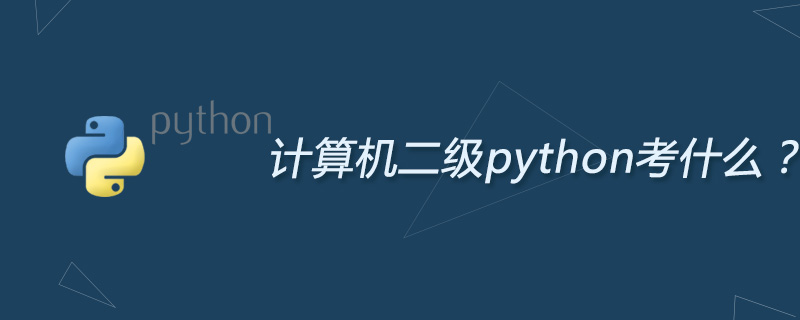Home >Backend Development >Python Tutorial >What is the computer level 2 python test?
What is the computer level 2 python test?
- little bottleOriginal
- 2019-05-18 09:41:5754528browse
The contents of the second-level computer python test include: 1. Basic syntax elements of the Python language; 2. Basic data types; 3. Program control structure; 4. Function and code reuse; 5. Combined data types; 6. File and data formatting; 7. Python computing ecology, etc.

The second-level computer Python language programming test was opened for the first time in September 2018, which means that the country has listed Python language as a key computer language to be cultivated in colleges and universities. Some friends want to try it, but they are not very clear about what they need to test. I will take you to find out below.
Basic requirements
1. Master the basic grammatical rules of the Python language.
2. Master no less than 2 basic Python standard libraries.
3. Master no less than 2 Python third-party libraries, and master the methods of obtaining and installing third-party libraries.
4. Ability to read and analyze Python programs.
5. Proficient in using the idle development environment and able to convert script programs into executable programs.
6. Understand the names of the main third-party libraries in the Python computing ecosystem in the following areas (not limited to): web crawlers, data analysis, data visualization, machine learning, web development, etc.
Exam content
1. Basic grammatical elements of Python language
1. Basic syntax elements of a program: program format framework, indentation, comments, variables, naming, reserved words, data types, assignment statements, and references.
2. Basic input and output functions: input(), eval(), print().
3. The writing style of the source program.
4. Features of the Python language.
2. Basic data types
1. Numeric types: integer types, floating point types, and complex types.
2. Numeric type operations: numerical operation operators, numerical operation functions.
3. String types and formatting: indexing, slicing, basic format() formatting method.
4. String type operations: string operators, processing functions and processing methods.
5. Type judgment and conversion between types.
3. Program control structure
1. Three control structures for programs.
2. The branch structure of the program: single branch structure, two branch structure, multi-branch structure.
3. Program loop structures: traversal loop, infinite loop, break and continue loop control.
4. Program exception handling: try-except.
4. Function and code reuse
1. Definition and use of functions.
2. Function parameter passing: optional parameter passing, parameter name passing, function return value.
3. Scope of variables: local variables and global variables.
5. Combined data types
1. Basic concepts of composite data types.
2. List types: definition, index, slice.
3. List type operations: list operation functions, list operation methods.
4. Dictionary types: definition, index.
5. Dictionary type operations: dictionary operation functions, dictionary operation methods.
6. File and data formatting
1. File usage: file opening, reading, writing and closing.
2. Dimensions of data organization: one-dimensional data and two-dimensional data.
3. Handling of one-dimensional data: representation, storage and processing.
4. Handling of 2D data: representation, storage and processing.
5. Use CSV format to read and write one-dimensional data files.
7. Python computing ecology
1. Standard library: turtle library (required), random library (required), time library (optional).
2. Basic Python built-in functions.
3. Obtain and install third-party libraries.
3. A third-party library that converts script programs into executable programs: pyinstaller library (required).
4. Third-party libraries: jieba library (required), wordcloud library (optional).
5. The broader Python computing ecosystem only requires knowledge of the names of third-party libraries, and is not limited to the following fields: web crawlers, data analysis, text processing, data visualization, user graphical interfaces, machine learning, Web development, game development, etc.
The above is the detailed content of What is the computer level 2 python test?. For more information, please follow other related articles on the PHP Chinese website!

